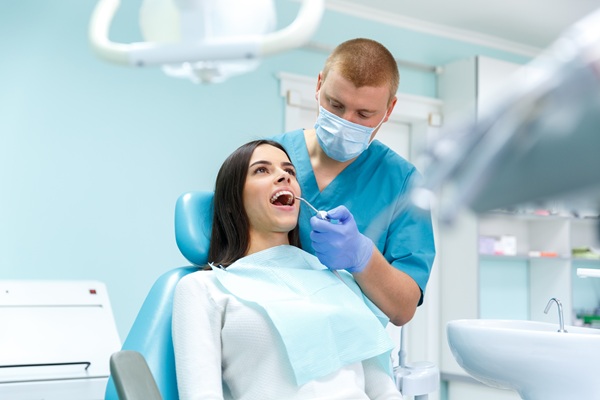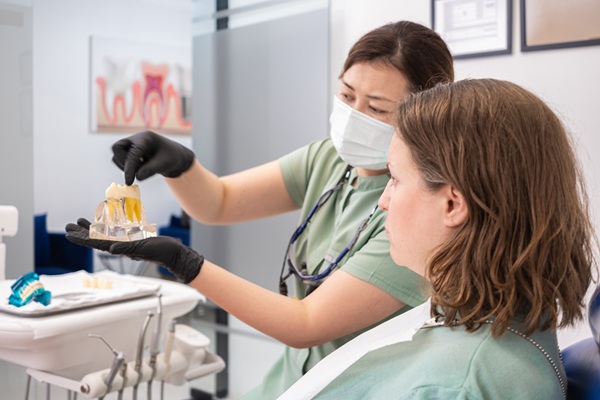Brushing and Flossing Teeth With Braces vs Invisalign

Dental hygiene is as important during teeth-straightening treatment with Invisalign® clear aligners or with braces as it is before or afterward. Arguably, dental hygiene becomes even more important during this type of treatment because the appliances and aligners create even more spaces for plaque to collect and decay to form. To prevent tooth decay, patients need to adopt different dental hygiene techniques and habits that are more effective during teeth-straightening treatment.
Brushing and flossing with braces
Patients with braces need to be careful to clean the spaces between the teeth and the wires. This can be accomplished by pointing the bristles of a soft-bristle brush toward the gum line at a 45-degree angle to the teeth and cleaning with either a circular or side-to-side motion. Some patients note the effectiveness of a brush that has long bristles along the edge and shorter bristles in the middle.
A patient with braces can use an electric toothbrush in place of a manual one. However, the back of the brush should not hit the braces, and the power level used should be moderate at most. Some people also use interdental brushes to clean between the teeth, under the wires, or around the brackets. Regardless of the type of toothbrush used to brush the teeth, adding fluoride toothpaste can help prevent cavities.
Flossing is critical to cleaning the spaces between teeth where food particles can get caught. It is challenging with braces because of the difficulty of getting the floss up under the wires, but there are tools that can help, such as a floss threader. This has a loop on one end through which to thread the floss. The other end is pointed to fit in between teeth. When it is pulled out the other side, it pulls the floss with it. Once the floss is between the teeth, it is disengaged from the floss threader and can be used in the usual way to clean the space between the teeth.
Brushing and flossing with Invisalign®
Because the aligners are removable, the techniques of brushing and flossing the teeth are no different than if no teeth-straightening treatment were taking place. However, patients need to perform dental hygiene more frequently with Invisalign® to prevent food and bacteria from building up under the aligners and on the teeth. In addition to brushing upon waking up and right before bed, patients should also brush after eating anything, whether a meal or a snack.
To prevent plaque buildup, the aligners must also be cleaned. Toothpaste can be abrasive, so it should not be used on the delicate trays. However, the aligners can be brushed with a damp toothbrush and rinsed with lukewarm water. Aligners should also be soaked in denture cleaner or cleaned with a liquid dish soap occasionally to ensure complete cleanliness.
Conclusion
Invisalign® and braces both can straighten the teeth, resulting in a better-looking smile and improved function of the mouth. With either treatment, it is important to maintain and adapt your dental hygiene routine so that it remains effective at removing plaque and preventing decay.
Request an appointment here: https://www.millarfamilydentistry.com or call Millar Family Dentistry at (817) 885-5214 for an appointment in our Weatherford office.
Check out what others are saying about our dental services on Yelp: Invisalign in Weatherford, TX.
Recent Posts
Invisalign® is a teeth-straightening treatment that entails wearing sets of custom-made transparent aligners over the teeth. Unlike traditional metal braces that use wires and brackets, the aligners are removable, which means wearers can take them off when they want to eat or brush their teeth. Learn about these clear aligners and how they are used to…
Invisalign® therapy is a type of treatment that a general dentist offers to individuals who have crooked, crowded, or gapped teeth. Each of these problems requires the attention of a dentist because they can lead to severe oral health problems. Additionally, after Invisalign® treatment, one's smile will greatly improve, thus resulting in better confidence and self-esteem. When…
If you want to improve your smile by straightening your teeth, traditional braces are not your only option. Invisalign® clear aligner trays are another alternative that continues to increase in popularity because of their efficacy and numerous benefits. Understanding the facts about Invisalign® can help patients make the right choice for a straighter and more…
For those seeking a straighter smile, Invisalign® is a popular and effective choice for dental patients of various ages. Using clear aligner trays, this system provides a more discreet treatment option, often with less discomfort and in less time than traditional braces. Straightening crooked teeth can result in a host of helpful benefits:Improved appearanceFewer headachesReduced…


